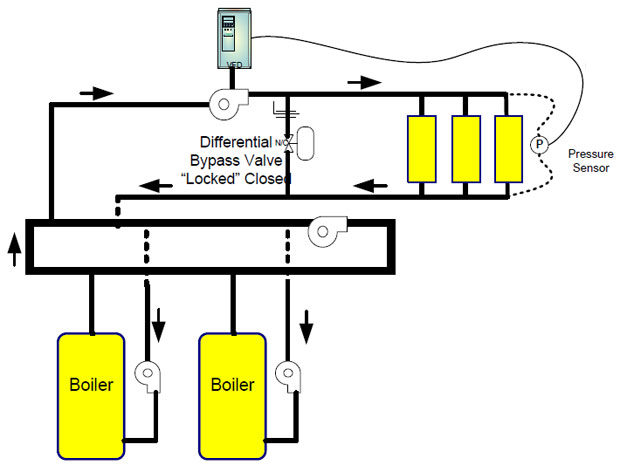Category
- Products
-
- FAQ
- Contact us

AC Drive Manufacturer
Home » Applications » AC drive on variable flow hydronic system
AC drive on variable flow hydronic system
Many variable flow hydronic systems utilize a bypass valve to balance pressure from the zones. Replacing these valves with an AC drive to control pumps can save energy. For example, in Figure 1, as zones become satisfied, the differential pressure control (P) modulates the bypass valve open to decrease flow to the zone loops. As pressure in the zone loop decreases, the bypass valve closes to ensure proper flow out to the zones.

AC drive Application
The bypass valve and electromechanical pressure control is replaced by an AC drive to control the pump and a new differential pressure sensor (see Figure 2). The pump speed (flow) is modulated to maintain system pressure. Placing the differential pressure sensor as shown ( farthest along the zone loop) can further increase control and possible savings.

Advantages

AC drive Application
The bypass valve and electromechanical pressure control is replaced by an AC drive to control the pump and a new differential pressure sensor (see Figure 2). The pump speed (flow) is modulated to maintain system pressure. Placing the differential pressure sensor as shown ( farthest along the zone loop) can further increase control and possible savings.

Advantages
- Decreased energy usage as pump speed varies with load.
- Electro-mechanical valve and pressure control is replaced with more accurate and reliable pressure sensor.
- Review boiler manufacturers specifications to determine low or no flow capabilities.
- AC drive minimum speed of the AC drive must be greater than boiler manufacturers flow specifications.
- Placing the differential pressure as shown in figure 2 provides optimum control and savings
- Original bypass valve is locked closed
Post a Comment:
You may also like:

